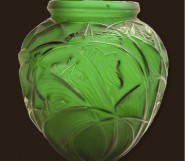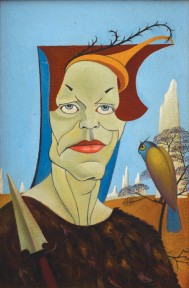Lot #4 - Leo Bensemann
-
Auction House:W T Macalister
-
Sale Name:40 Years of Leo Bensemann
-
Sale Date:28 Mar 2012 ~ 6:30pm (NZDT)
-
Lot #:4
-
Lot Description:Leo Bensemann
(1912-1986)
Huntsman, a small but very striking work painted on board, was first exhibited under that title at the 1938 Group Show, the first in which Bensemann's
Oil On board
288 x 190mm -
References:Hunstman was reproduced in A Second Book of Leo Bensemann’s Work (Caxton, 1952) and on the cover of Landfall 157 (March 1986); see also Simpson, Fantastica, p. 25
-
Notes:Huntsman, a small but very striking work painted on board, was first exhibited under that title at the 1938 Group Show, the first in which Bensemann's work was included. Although the painting is not signed or dated, a preliminary drawing in pencil which closely resembles the finished work is signed LEO BENSEMANN and dated MCMXXXVIII (1938). This drawing is reproduced in Otto, Portraits, p. 48. The figure of the Huntsman appears against a background of spiky white pinnacles looking as if they are made of marble or alabaster. In some respects this weird landscape anticipates Bensemann's marble and limestone Takaka landscapes of the 1970s and 1980s. The bright blue background reads as sky but has no distinguishing features such as clouds; it could just as well be a backdrop in a theatre. On the right an owl with a distinctive blue head and tail feathers, and a large yellow eye perches in a delicately depicted tree. The owl is a recurrent figure in Bensemann's graphic art; for example, they appear in two of the Fantastica drawings, Faustus I and The Arabian Nights. The owl is also central to Bensemann's first bookplate drawing for himself (other elements in the drawing are a candle, a snake and a severed arm), which suggests that to some degree the owl is a sign of the artist himself. The owl also connotes wisdom, all-seeing prophecy, night and (sometimes) death. Turning to the figure of the huntsman, the first thing to note is the general oddity and weirdness of the figure and how it is presented. Asregards clothing, he appears to be wearing a dark brown shaggy garment, doubtless made from an animal skin, and a peaked orange cap, which has in it a feather-like decoration, possibly a thorny branch. It is hard to tell whether the distinctive brown shapes which come down on both sides of the head like ear flaps are part of his outfit or purely decorative - part of the picture rather than part of the Huntsman's garment. The dark blue piece attaching to this brown shape is either purely abstract, or if 'realist' some sort of veil or hanging piece (as if to keep weather off the back). Also part of the picture is the stone or metal head of a spear, being held by the Huntsman and resting against his shoulder. Several features of the huntsman's facial features are noteworthy; he has large pale blue eyes, with no eyelashes and peculiar truncated eyebrows that look as if they have been aggressively plucked. The full lips are rosy pink. The colour of the skin appears grey and lifeless. The prominent lines on the neck are really peculiar - almost like the lineaments of the lower part of a naked body seen from the back. The figure is vaguely disturbing - the expression is neutral but in overall effect is disconcerting. The Huntsman is a familiar figure in folklore, especially German folklore. For instance, a huntsman appears in several of the stories collected by the Grimm Brothers. In Snow White, it is a huntsman who is ordered by the Evil Queen to take Snow White into the woods and kill her; instead he falls in love with her and allows her to escape. The Skilful Huntsman tells of a young locksmith who learns the art of hunting from an old hunter and uses his skills to defeat three giants and win the hand of a beautiful princess. Then there are The Twelve Huntsmen, who are really girls dressed as men, who accompany the king on his hunting forays, one of whom marries the king after he recognises her as his spurned fiancé. It is possible, too, that Bensemann had in mind the huntsman element in the plot of Carl Maria von Weber's opera Der Freischütz (1821) with its famous hunting scene set I the Wolf 's Glen. Whatever his source, Bensemann's Huntsman is a perfect example of the Fantastica mode being applied to oil painting. It is a powerful and unforgettably distinctive work. This work was included in Leo Bensemann: A Fantastic Art Venture at Christchurch Art Gallery in February 2011.
-
Estimate:NZ$9,000 - 11,000
-
Realised Price:
-
Category:Art
This Sale has been held and this item is no longer available. Details are provided for information purposes only.










